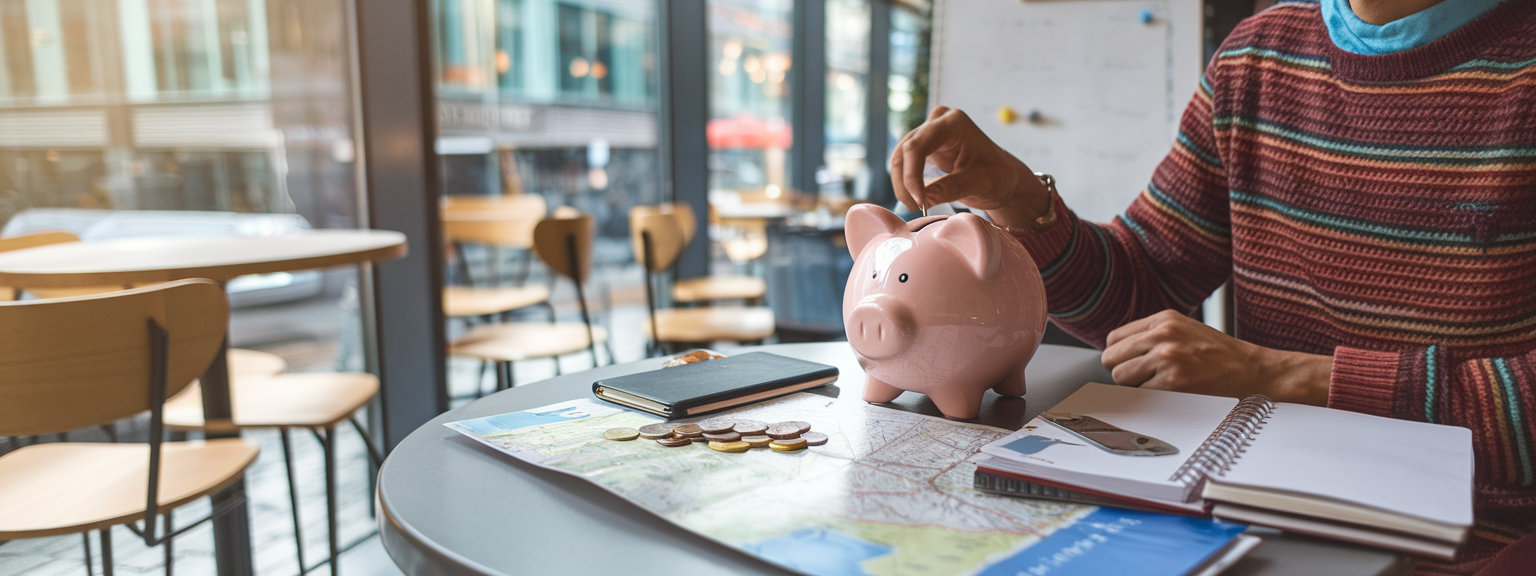Budgeting for Travel: The Ultimate Guide to Saving More and Seeing More
Traveling doesn’t have to mean emptying your savings. With clear goals, a simple travel budget planner, and a few smart habits you can cut costs, prioritize experiences, and actually travel more often. This guide to Budgeting for Travel walks you through setting up a travel fund, tracking expenses, finding affordable transport and lodging, and planning cheap-but-rich itineraries so you see more while spending less. If unpredictable trip costs frustrate you or you don’t know where to start saving, these practical travel savings strategies will help you build momentum fast.
📍Must-See Attractions
📝 Step-by-Step Guide: Budgeting for Travel — Set Goals, Build a Travel Fund, and Track Every Expense
Start with a clear savings goal: name the destination, target dates (or range), and total estimated cost. Break that total into monthly and weekly micro-goals to make progress measurable. Use a simple travel budget planner template (spreadsheet or app) to log flights, lodging, food, transport, attractions, and a contingency line for unexpected costs. Automate transfers to your travel fund the day after payday to make saving effortless and avoid the temptation to spend.
Set a clear travel savings goal
Define destination, dates range, and a total target; break it into monthly and weekly micro-goals so progress is visible and motivating.
Image alt text: “Travel savings goal chart in travel budget planner”
Open a dedicated travel fund (automated transfers)
Use a separate account, high-yield savings, or a labeled jar to avoid accidental spending. Set up automatic transfers timed with payday and note interest or bonus rates.
Image alt text: “Travel fund jar labeled ‘Vacation'”
Use a travel budget planner template
Track flights, lodging, food, transport, activities, and a contingency line. Include payment due dates and refunds policy notes to avoid late fees.
Image alt text: “Travel budget planner spreadsheet with expense columns”
Hunt off-peak and flexible dates
Flexibility with dates can save 20–50% on flights and hotels. Use month-view calendars on flight search engines and search adjacent airports for better fares.
Image alt text: “Calendar with flexible travel dates highlighted”
Fare alerts, price trackers, and error fares
Set alerts with Google Flights, Skyscanner, Hopper, or Kayak. Watch for error fares and act quickly — have your passport and payment details ready to confirm a deal.
Image alt text: “Flight price alert on smartphone”
Choose alternative lodging
Compare nightly price per person: hostels, homestays, and short-term rentals often beat hotels. For longer stays, negotiate weekly or monthly discounts.
Image alt text: “Cozy hostel common room with travelers”
Eat like a local: markets and street food
Save on meals while enjoying authentic cuisine. Seek markets, lunchtime specials, and bakeries for breakfast. Splurge selectively on one memorable meal.
Image alt text: “Street food market with local dishes”
Use public transport, bikes, and walking
Avoid taxis when possible — bus and metro passes often save money. Rent a bike or walk to experience the neighborhood and cut transit costs.
Image alt text: “Bicycle rental by city square”
Buy local passes and citycards when it makes sense
Calculate the attractions you plan to visit and only buy a pass if the total entry fees exceed the pass cost.
Image alt text: “City pass brochure and map”
Travel insurance smartly
Shop for policies that cover cancellations, health emergencies, and baggage. For costly trips, insurance protects your investment and helps avoid catastrophic losses.
Image alt text: “Travel insurance policy documents”
🎭 Local Culture & Experiences
Cheap or free cultural highlights
Free museum days, outdoor concerts, seasonal festivals, public markets, processions, and community workshops deliver high cultural value for low cost. Look at municipal event calendars and local tourism sites for dates and maps.
Practical tips for experiencing culture on a budget
- Visit local markets for tasting menus and snacks.
- Seek student, youth, or senior discounts and book online where cheaper.
- Join free walking tours and tip the guide — it’s affordable and informative.
- Check library and community boards for low-cost workshops or performances.
Anecdotes that show the value of smart choices
“During a two-week trip I saved $60 by timing my museum visits on free days and spent the savings on a local cooking class — best meal of the trip.” — Emma, budget traveler.
“Some of my favorite memories are from impromptu street performances, not expensive attractions.” — Marco, local guide.
Image alt text: “Local night market with music — affordable local culture”
🔑 Hidden Gems & Insider Tips
Money moves that quietly save hundreds
Use local ATMs strategically (avoid dynamic currency conversion) or prepaid travel cards to minimize foreign transaction and withdrawal fees. Consider one-way tickets or open-jaw itineraries if they reduce fare costs. Shoulder-season travel delivers lower prices and fewer crowds while keeping fair weather.
Leverage loyalty and negotiation
Use credit card sign-up bonuses and category spending to earn travel credits (watch annual fees). Check hostel notice boards, local Facebook groups, and Couchsurfing events for cheap meetups and low-cost experiences. Negotiate small services politely where culturally appropriate.
Smart tools and packing hacks
Use cashback apps and browser extensions for booking accommodations and experiences. Pack multipurpose items (quick-dry towel, universal adapter, compact laundry soap) to avoid buying abroad.
Final insider reminder
Small cumulative actions (using fare alerts, packing light, avoiding dynamic currency conversion) add up. Track your wins in your travel budget planner to see how micro-savings fund bigger experiences.
Image alt text examples: “Traveler using flight price tracker app”, “Local market bargains”
🗓️ Sample Itinerary or Day Plan
Budget Example: 1 Day in a Mid-Size European City (est. costs in USD)
This sample day demonstrates how a few low-cost choices let you cover highlights without overspending. Use it as a model for building a per-day budget in your travel budget planner.
- 08:00 — Breakfast at local bakery: pastry + coffee — $5 (walk)
- 09:00 — Free walking tour (tip $5): orientation and history — $5 (walk)
- 11:30 — Museum with reduced admission / free day — $0–$10 (public tram $2)
- 13:00 — Lunch at market stalls — $8 (walk)
- 14:30 — Rent bike for 3 hours — $10 (bike share)
- 17:00 — Visit a viewpoint or free park — $0 (walk)
- 19:00 — Small-plate dinner at local eatery — $12
- 21:00 — Free outdoor concert or local pub with live music — $0–$10 (drinks)
Daily total estimate: $42–$62 (lower with free museum day and minimal tips). Adjust for city differences and include a transport pass if visiting multiple paid sights. For a weekend (2–3 days), expect $90–$180 total depending on accommodation choices.
Image alt text: “Budget day itinerary in city with bike and market”
💡 Travel Tips Specific to the Destination
Cities
Pack comfortable walking shoes, buy daily transit passes, and use citycards only if you’ll visit enough paid attractions. Shoulder months give easier availability and better prices.
Beaches & Islands
Bring reef-safe sunscreen and a refillable water bottle. Book ferries in advance and consider guesthouses inland. Watch for seasonal surcharges and prefer mid-week stays to cut cost.
Road Trips
Plan fuel-efficient routes, split rental and tolls with travel partners, and use grocery stores for picnic meals. Factor parking and insurance into your travel budget planner.
Remote or Developing Destinations
Bring cash in small denominations and learn local tipping or negotiation norms. Register with your embassy for extended stays and check health advisory notices. Pack essential meds and a basic first-aid kit.
Packing & local etiquette
Pack multi-climate layers, compact laundry soap, a reusable water bottle, and chargers/adapters. Research greetings, dress codes for religious sites, and haggling norms to avoid cultural missteps and extra costs.
Bringing It All Together
Budgeting for travel is about choices and priorities — automate savings, use a travel budget planner, pick the right timing and tools, and trade expensive conveniences for authentic, low-cost experiences. Small, consistent habits unlock more trips and richer memories. What’s the smartest trip-savings trick you’ve used — and where did it take you? Share in the comments below and help others plan their next affordable adventure.
Call to action: Comment with your favorite travel savings tips, share this guide on social media, and subscribe for a downloadable travel budget planner and exclusive travel savings offers.


![[Houston International Food Platter] [Vibrant platter of global dishes showcasing Houston international food]](https://roamwriters.com/wp-content/uploads/2025/11/houston-international-food-bold-flavors.png)
![[Cultural Etiquette International Meeting] [Colleagues exchanging greetings in an international office demonstrating Cultural Etiquette]](https://roamwriters.com/wp-content/uploads/2025/11/cultural-etiquette-international-meeting.png)

![[Travel Emergencies Response] [Traveler checking documents and phone for help after travel emergencies]](https://roamwriters.com/wp-content/uploads/2025/11/travel-emergencies-preparation-guide.png)